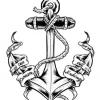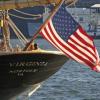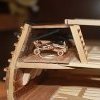-
Posts
97 -
Joined
-
Last visited
Reputation Activity
-
 Pierretessier got a reaction from VACorsair in Workshop Advice
Pierretessier got a reaction from VACorsair in Workshop Advice
I agree with adjustable table or multiple height work surfaces.
I've got sitting stations on the left side, with a solid oak top desk and band saws. On the right side Ive got an oak table raised to bench height and my floor model drill press. I can switch between the two sides when my back gets sore....
I hate getting older.
-
 Pierretessier got a reaction from billocrates in HMS Surprise by Rossi46 - FINISHED - Artesania Latina - Scale 1:48 - First Wooden Ship Build
Pierretessier got a reaction from billocrates in HMS Surprise by Rossi46 - FINISHED - Artesania Latina - Scale 1:48 - First Wooden Ship Build
Have not been here for a bit....WOW I am floored. This is museum quality. Nice work mate!
-
 Pierretessier got a reaction from Eddie in Trabakul by donrobinson - FINISHED - MarisStella - 1:32 scale
Pierretessier got a reaction from Eddie in Trabakul by donrobinson - FINISHED - MarisStella - 1:32 scale
'She is looking sweet indeed.
-
 Pierretessier got a reaction from Elijah in Trabakul by donrobinson - FINISHED - MarisStella - 1:32 scale
Pierretessier got a reaction from Elijah in Trabakul by donrobinson - FINISHED - MarisStella - 1:32 scale
'She is looking sweet indeed.
-

-
 Pierretessier got a reaction from Canute in Raleigh 1777 by KennyH78 - Scale 1:96 - Continental Frigate - Hahn Plans
Pierretessier got a reaction from Canute in Raleigh 1777 by KennyH78 - Scale 1:96 - Continental Frigate - Hahn Plans
Looks interesting, I'm pulling up a chair, popcorn at hand.
-
 Pierretessier got a reaction from mtaylor in Raleigh 1777 by KennyH78 - Scale 1:96 - Continental Frigate - Hahn Plans
Pierretessier got a reaction from mtaylor in Raleigh 1777 by KennyH78 - Scale 1:96 - Continental Frigate - Hahn Plans
Looks interesting, I'm pulling up a chair, popcorn at hand.
-
 Pierretessier got a reaction from KennyH78 in Raleigh 1777 by KennyH78 - Scale 1:96 - Continental Frigate - Hahn Plans
Pierretessier got a reaction from KennyH78 in Raleigh 1777 by KennyH78 - Scale 1:96 - Continental Frigate - Hahn Plans
Looks interesting, I'm pulling up a chair, popcorn at hand.
-
 Pierretessier got a reaction from popeye the sailor in Prince de Neufchatel by Heronguy - Model Shipways - Scale 1:64
Pierretessier got a reaction from popeye the sailor in Prince de Neufchatel by Heronguy - Model Shipways - Scale 1:64
Hey Doug,
Looking real good, totally agree regarding fairing the blocks. I just spent the weekend with band aids on my thumb. Not that I'm much of an othority on this but I am finding that a pillow and various blocks of wood with coarse sandpaper the best assurance to a nice hull. It's taking a lot of time and patience, trying to keep it all in one piece is key. All in all it's pretty relaxing when you just take your time..... Hey there's my new signature....
Keep up the good work....
-
 Pierretessier got a reaction from coxswain in Prince de Neufchatel by Heronguy - Model Shipways - Scale 1:64
Pierretessier got a reaction from coxswain in Prince de Neufchatel by Heronguy - Model Shipways - Scale 1:64
Hey Doug,
Looking real good, totally agree regarding fairing the blocks. I just spent the weekend with band aids on my thumb. Not that I'm much of an othority on this but I am finding that a pillow and various blocks of wood with coarse sandpaper the best assurance to a nice hull. It's taking a lot of time and patience, trying to keep it all in one piece is key. All in all it's pretty relaxing when you just take your time..... Hey there's my new signature....
Keep up the good work....
-
 Pierretessier reacted to Gaetan Bordeleau in 74-gun ship by Gaetan Bordeleau - 1:24
Pierretessier reacted to Gaetan Bordeleau in 74-gun ship by Gaetan Bordeleau - 1:24
COMPONENTS OF A FULLY OPERATIONAL ROPE MACHINE WHICH CONTROLS EVERY ASPECT
I have seen many versions of rope machine on this forum. There are many ways to fabricate a machine but I think that there are some basics principles which need to be respected to obtain a rope with all the necessary qualities like tension, number of turns, stiffness of the rope. To turn a rope is just a matter to have some components and understand why they are used. 1 of the most common missing item is the swivel bearing. It controls the number of turns entering in the fabrication of the rope, it regularizes the number of turns entering by eliminating the surplus of turns by a balancing action.
3 photos: swivel bearing, explanation of the parts of the machine, extract from .xls file to predict rope diameter.
-
 Pierretessier reacted to Gaetan Bordeleau in 74-gun ship by Gaetan Bordeleau - 1:24
Pierretessier reacted to Gaetan Bordeleau in 74-gun ship by Gaetan Bordeleau - 1:24
Mike , here how it looks behind the movie screen.
-
 Pierretessier reacted to Gaetan Bordeleau in 74-gun ship by Gaetan Bordeleau - 1:24
Pierretessier reacted to Gaetan Bordeleau in 74-gun ship by Gaetan Bordeleau - 1:24
Mike, you are right about the glass, this one is an ordinary glass and can act sometimes like a mirror and this we do not want.
Anti reflection glass would be much better.
There are 2 levels of protections; the first one, more visual than protecting from the dust, a movie screen and the second one a light fabric. For this case a glass would be expensive and mostly too heavy to manipulate.
-
 Pierretessier reacted to KenW in Trabakul by donrobinson - FINISHED - MarisStella - 1:32 scale
Pierretessier reacted to KenW in Trabakul by donrobinson - FINISHED - MarisStella - 1:32 scale
What kind of lathe are you using? It looks like it is more than just your dremmel, yet it can deal with small pieces of wood.
Excellent work on the model.
-
 Pierretessier got a reaction from rshousha in 74-gun ship by Gaetan Bordeleau - 1:24
Pierretessier got a reaction from rshousha in 74-gun ship by Gaetan Bordeleau - 1:24
Tabernac c'est compliquez .
Excuse my french. Loving the details and its just the beginning. So glad to be on board to see this build.
-
 Pierretessier reacted to Chuck in Chuck's planking videos...
Pierretessier reacted to Chuck in Chuck's planking videos...
No not exactly. The plank is first bent edgewise as shown and then bent the other way as needed. The one plank on the video if I remember correctly was lower on the hull and didnt require any bending the other way. It was so slight that I didnt need to. But in almost all cases the plank is pre shaped so that it immediately sits against the bulkhead edges. Thats why you dont have to clamp them. The CA dries so quick that its an immediate bond. Its only when folks dont pre-shape that some sort of clamp is required.
I glue two bulkheads at a time and work my way across the hull in scale lengths. Yes there is sanding butnot that much. If the planks fit well than not much sanding is required.
Just like this plank below.....the plank is always bent edge-wise first and then the other way so its completely pre-shaped to fit so no extra bending is needed. In this case below I pre-spiled the plank with a laser cutter edge-wise, but if I was using a plain strip like in the video....it would have been bent to look just like this before gluing.
Here is some more detail
Here is a straight plank as if I were going to place it on the hull. It could be at the bow or at the stern. Most beginners would try to force this into place and the top edge of the plank would lift off the hull and not sit flush against the bulkheads. Some fight with it using pins and clamps and it gets messy. Holding it without bending like shown reveals the gap . Note the widest point of that gap.
Mark this location as the center of the gradual curve you will need.
In the next picture, after bending, you can see how nice it fits and how it is flush against the bulkheads. No forcing needed. Its a perfect fit. Note the dot I marked on the plank for the apex of the curve or the widest part of the gap..You could use the compass method or the tape method to find the exact curve, but I prefer to eyeball it like this. Visually its easy to see the curve after a little practice. I always over bend slightly.
Now all I have to do is bevel the edge that meets the plank already on the hull for a tight fit (just knock off the edge as in the video) and darken the seem as I did in the video with pencil and glue it on. You can see that in this rare instance not much bending other than edge-bending was needed because it was low on the hull.
-
 Pierretessier reacted to Chuck in Chuck's planking videos...
Pierretessier reacted to Chuck in Chuck's planking videos...
I advocate no water. You really dont need it. For the kinds of bends we are talking about, the heat does the trick. There will be some spring-back......but just overbend to begin with. The key is to line-off the hull first. Its easier when you have a plan.
That is described here.
http://modelshipworldforum.com/resources/Framing_and_Planking/Lining%20Off%20your%20hull%20for%20planking.pdf
And another by David Antscherl here....... where he cuts the planks to shape rather than bend it in that third plane.
http://modelshipworldforum.com/resources/Framing_and_Planking/Planking%20primer.pdf
But lining off the hull is half the battle. Then realizing the planks are bent and not straight to fit the hull properly in that edge-wise plane. Whatever way you eventually get it there. But force bending a straight plank is a really frustrating way to fight through planking. IMHO
-
 Pierretessier reacted to mtbediz in Santa Maria by mtbediz - FINISHED - handmade kit by a friend
Pierretessier reacted to mtbediz in Santa Maria by mtbediz - FINISHED - handmade kit by a friend
Thanks for nice comment Pierre. Scale is 1:50
-
 Pierretessier reacted to Worldway in Bluenose by Worldway - Model Shipways - Scale 1:64
Pierretessier reacted to Worldway in Bluenose by Worldway - Model Shipways - Scale 1:64
Thanks for the comments Fnkershner, very good idea. But I was going to post tonight that I was wrong about the clamp that I have. I absolutely love it for planking. I just had the ship installed upside down. With it installed the correct way, it is stable and great that you can pose it any any angle. I'm continuing with the planking, nothing really special to report. Here is a couple of pics.
Whoever thought of turning binder clips into planking clamps needs to have a ticker taper parade down New York City. Fantastic idea. As you can I used one Micro Mark planking clamp because I ran out of binder clips. They work well too but take a bit to install.
I think planking is going to take a while.
Members
-
 Pierretessier reacted to Gaetan Bordeleau in 74-gun ship by Gaetan Bordeleau - 1:24
Pierretessier reacted to Gaetan Bordeleau in 74-gun ship by Gaetan Bordeleau - 1:24
Roughly, 62 frames are made of 1000 parts, each part has 4 sides to sand.
The setup is as follow : inside curve, ends, outside curves.
Then the tracing paper is remove with a scraper. A faster method is to pass the parts in the sanding drum, This machine is quite precise, much more than a planer because the adjustment can be made in 0,001 inch increment.
Frames part are divided in 3 groups : left, center and right components.
Left and right are put aside to keep the center parts which are going to be use to prepare the keel.
-
 Pierretessier got a reaction from mtbediz in Santa Maria by Pierretessier - Marisstella - 1:60
Pierretessier got a reaction from mtbediz in Santa Maria by Pierretessier - Marisstella - 1:60
Thanks for the kind words. For those following, a little update, I did some preliminary panelling on both sides at the stern and bulkhead 11. Next I started fairing the blocks at the bow, this is a slow going process.
Not much to look at I know but this step takes time. You know what they say! "The foundation to a good planking job starts with proper fairing of the hull. "
-
 Pierretessier got a reaction from piter56 in Santa Maria by Pierretessier - Marisstella - 1:60
Pierretessier got a reaction from piter56 in Santa Maria by Pierretessier - Marisstella - 1:60
Thanks for the words of encouragement, and likes. Now that the bulkheads are dry and everything is lined up properly it was time to add some supports to help lock the hull before fairing. I decided to use bass wood as it is a bit harder then balsa. I began by glueing stock board I had to make up the blocks needed to create the supports, I then dry fitted them to make sure there was no twisting action.
-
 Pierretessier reacted to bwood in HMS Vanguard by bwood - FINISHED - Model Shipways
Pierretessier reacted to bwood in HMS Vanguard by bwood - FINISHED - Model Shipways
In the past two months I have completed the hull chain plates and deck hammock cranes and stanchions. I then turned my attention to the mast yards and sails. So far I have sewn the main sail to the main yard and temporarily pinned that to the main mast. I've also sewn the main top sail to the main top mast and temporarily pinned that to the main mast as well. There are a couple of details that are not explained very well on the plans. The first is the fore and main jeers are shown on a detail on Plan Sheet 9 but are not detailed far enough. A blow up of a sample jeer would have been nice indicating the tread size and configuration. The other is the truss pendants for the fore and main lower yards shown on Plan Sheet 7. Both these details were completed with the help of Lennarth Peterson's "Rigging Period Ship Models". So, for the foreseeable future, I will be sewing sails to yards and temporarily pinning the yards to the masts.
Bruce
-
 Pierretessier got a reaction from Nirvana in Santa Maria by Pierretessier - Marisstella - 1:60
Pierretessier got a reaction from Nirvana in Santa Maria by Pierretessier - Marisstella - 1:60
Thanks for the words of encouragement, and likes. Now that the bulkheads are dry and everything is lined up properly it was time to add some supports to help lock the hull before fairing. I decided to use bass wood as it is a bit harder then balsa. I began by glueing stock board I had to make up the blocks needed to create the supports, I then dry fitted them to make sure there was no twisting action.
-
 Pierretessier got a reaction from piter56 in Santa Maria by Pierretessier - Marisstella - 1:60
Pierretessier got a reaction from piter56 in Santa Maria by Pierretessier - Marisstella - 1:60
Thanks for the kind words. For those following, a little update, I did some preliminary panelling on both sides at the stern and bulkhead 11. Next I started fairing the blocks at the bow, this is a slow going process.
Not much to look at I know but this step takes time. You know what they say! "The foundation to a good planking job starts with proper fairing of the hull. "














